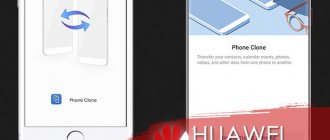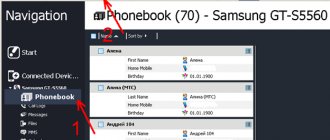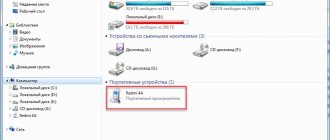Cleaning your phone from unnecessary files
If your Android phone's memory is full, the first thing we recommend is deleting apps, downloads, and system junk. The largest amount of space on a smartphone is occupied by the download folder and installed applications. An effective way to free up enough memory is to remove everything unnecessary.
How to clear your phone's internal memory:
- Analyze all applications on the smartphone's desktop. Most likely, you will be able to find several unnecessary or less useful applications that have not been used for a long time. It is better to delete them in order to free up memory;
- Another common reason why your phone's memory is full is because it stores a lot of videos and photos. We can filter out bad photos and useless videos. This may already solve the problem. If all the media data is needed or deleting it did not help free up enough memory, all that remains is to transfer the files. We recommend moving the data to a flash drive or transferring it to a computer;
- Clear downloaded files from messengers. They download sent photos to your phone by default. Because of this, various postcards, congratulations, photos of strangers, etc. accumulate in the smartphone storage. The easiest way to clear this partition is to use your computer. Through Explorer we can open the folder of the same name from the messenger and remove its contents;
- Check the folder where the browser downloads all files. A lot of data accumulates here; cleaning it will help free up a lot of space.
These are the most effective ways to free up space on your phone, but they don’t work for everyone. Is the low memory problem still there? – Read on.
Prohibiting synchronization with other services
Xiaomi, Meizu, Samsung offer their cloud storage services, and I force you to register with them. This is useful because it stores settings for your calendar, music, photos, and contacts. But, as in the previous situation, this can get in the way if, for example, you reject the Xiaomi ecosystem in favor of the one proposed by Google.
To prevent your phone from exchanging data with developer services, just take a couple of steps. Let's demonstrate this using the example of Xiaomi.
Using this scheme, you can disable synchronization with any services of the smartphone manufacturer.
As you know, almost all Android smartphones come with . These services include various applications such as Google Music, Google Photos and so on. Google Photos is an application with which you can quickly and conveniently synchronize your photos with cloud storage, edit them and simply view them. However, some users may experience problems at this stage.
Once Google Photos is installed on your device, it will ask you to sync photos to your cloud storage. At this stage there should be no problems. You're using the app, your photos are syncing, and suddenly you decide to delete Google Photos, no matter what the reason. And this is where the problems faced by Business Journals' David Arnott begin.
He claims he noticed hundreds of photos in his cloud storage even after he deleted Google Photos. This will confuse any user, because, based on intuition, the user is sure that after deleting the application, photos will no longer be saved in the cloud. However, the transfer is not carried out using the application itself, but using system services, and that is why, after deleting the application, photos continue to be saved in the cloud storage.
On the one hand, this will cause an incomprehensible waste of Internet traffic, on the other hand, the battery charge will certainly suffer from this. However, these are not the main problems. In my opinion, the main thing is surveillance of users. After all, in fact, Google does not violate anything, but your photos will be transferred to the company’s servers, and you may never know about it.
Google always tries to impose on users various services that provide the company with some information about the user’s actions. An excellent example would be determining your geolocation on a map: Google very much asks the user to enable the function in order to improve its own services.
With photos of you, Google will know where you've been, who you hang out with often, what your interests are, what you look like, or what your favorite food is. This can be considered just another attempt to scare readers, but we live in the 21st century, and that probably says it all. To disable photo backup, go to Settings - Accounts - Google - Uncheck the photo synchronization box.
What do our readers think? Is this a sign of Google's desire to learn more about you?
Based on materials from phonearena
With every year of computer life, the number of accumulated files grows. The volume of luggage is already so large that you are thinking about buying an additional hard drive? First, let's consider a simpler and cheaper option - moving to cloud storage.
Cloud Mail.Ru
So, as mentioned above, you will first need to create an email account, after entering which the cloud service will be displayed in the panel at the top in the projects tab. This is the Mile cloud. How to use it? As easy as pie.
Initially, 25 GB of disk space is offered. carried out using the corresponding button, which can be used to add several objects at once. The limitation concerns only the size of the uploaded file - it should not exceed 2 GB. Before starting the download, you can use additional functions, for example, create, after which you can just as easily move and delete files. Please note: it does not have a “Trash”, as in the same Yandex service, so it will not be possible to restore deleted information.
The function of creating, viewing or editing files can be very useful. Let's say we have a Word document (or it is created directly in the repository). Changing it directly in the cloud can be as easy as if the user were launching the editor on a computer. Upon completion of work, we save the changes, after which synchronization occurs again.
Freeing up storage on Android
F1comp has already talked about how to clear memory on Android devices. I'll just add a little.
Scan your gadget for viruses
Determining what the storage of a “healthy” device is filled with is usually not difficult - just open the settings and go to the “ Memory ” section. Here is detailed information about how much space the operating system takes up, how much - applications along with their data, how much - images, videos, music, downloads, cache, etc. And if you delete something (transfer it to another medium, for example, a microSD card), free space will appear in the gadget’s memory.
In case of malware infection, the picture may look like this:
- The memory does not seem to be full, but the free space that is designated as available is disproportionately small. For example, the device memory is 32 GB, the content takes up 10 GB, and the unallocated space is only 10 MB.
- The memory is almost completely full of application and media data, but deleting installed programs does not free it up.
- The system shows that there is free space in the device storage, but when you try to install an application or save a file, you receive a message that the memory is full.
Yandex cloud: how to use?
With the Yandex service, in principle, things are almost identical. The functional set, in general, does not differ much.
But the developers of this service thought that the user could delete files completely by accident. This is where the so-called “Trash” comes to the rescue, into which information is placed when deleted. It works like a standard computer service. True, data recovery tools are not applicable to it if they have already been deleted from the Recycle Bin. Nevertheless, the function is very useful.
Disable synchronization in Windows OneDrive
For Windows 8.1
OneDrive for Windows 8.1 offers the most convenient sync options yet.
Call the context menu by right-clicking on the “Archive” folder and selecting “Make available online-only”.
Similarly, we refuse to synchronize an individual file or group of files.
For Windows 7 and Windows 8
- Right-click on the One Drive icon in the tray to call up the context menu and select “Settings”;
- Go to the “Choose folders” tab and click the “Choose folders” button;
- Activate the option “Choose folders to sync” and uncheck the box next to the “Archive” folder.
Who should be denied synchronization?
Using , and Cloud Mail.ru will not surprise anyone. But we rarely consider them as an alternative to a hard drive. But this is a great way to provide free storage of not the most current files: many cloud storage providers provide up to 15 GB for free, and you could get 100 GB on the Mail.ru Cloud.
Do you also have folders with photographs from 10 years ago, your graduation project and calculations from your previous job? If you rarely use them, it makes sense to refuse synchronization and save only one copy on the cloud. This will save valuable GB of disk space for new “tenants”.
Solving some problems
Many owners of Android devices can use them, but do not know their Google account information, email, or password. This is most typical for representatives of the older generation and inexperienced users who ordered service and first setup at the store where the device was purchased. The obvious disadvantage of this situation is the inability to use the same Google account on any other device. True, users who want to disable data synchronization are unlikely to be against it.
Due to the instability of the Android operating system, especially on smartphones in the budget and mid-budget segments, failures in its operation can sometimes result in a complete shutdown or even a reset to factory settings. Sometimes, after turning on, such devices require entering the credentials of a synchronized Google account, but for one of the reasons described above, the user does not know either the login or password. In this case, you also need to disable synchronization, albeit at a deeper level. Let's briefly look at possible solutions to this problem:
- Create and link a new Google account. Since the smartphone does not allow you to log in, you will have to create an account on a computer or any other properly working device.
Once a new account is created, its data (email and password) will need to be entered when setting up the system for the first time. The old (synchronized) account can and should be deleted in the account settings.
Note: Some manufacturers (for example, Sony, Lenovo) recommend waiting 72 hours before linking a new account to your smartphone. According to them, this is necessary so that a complete reset and deletion of information about the old account is performed on Google servers. The explanation is dubious, but the anticipation itself sometimes really helps.
- Contact the service center. Sometimes the cause of the problem described above lies in the device itself and is of a hardware nature. In this case, you won’t be able to disable synchronization and linking of a specific Google account yourself. The only possible solution is to contact an official service center. If your smartphone is still under warranty, it will be repaired or replaced free of charge. If the warranty period has already expired, you will have to pay to remove the so-called lock. In any case, this is more profitable than buying a new smartphone, and much safer than tormenting it yourself, trying to install unofficial firmware.










